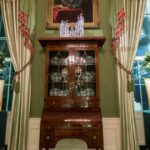
Astronauts on the International Space Station (ISS) strapped into their “lifeboat vehicles” and braced for an emergency evacuation after a defunct Russian satellite shattered into hundreds of pieces.
That included Boeing’s plagued Starliner spacecraft, which officials said could have made it to Earth if debris crashed into the ISS.
“We used Starliner for that safe haven capability,” said Steve Stich, manager of NASA’s Commercial Crew Program (CCP).
“(The astronauts) got in the spacecraft, powered the vehicle up, closed the hatch and were ready to execute … an emergency unlocking (from the ISS) and landing.”
BOEING DISCUSSES WHY ASTRONAUTS REMAIN IN SPACE
Starliner’s June 5 launch with astronauts Suni Williams and Butch Wilmore on board was Boeing’s first manned expedition to the ISS since 2014, when Boeing and NASA agreed to a $4.2 billion public-private partnership.
Helium leaks in the propulsion system and faulty thrusters turned a week-long mission into an indefinite stay in space.
TAKE COVER: A RUSSIAN SATELLITE IMPLODES
Starliner is docked at the ISS as engineers collect data to fix the issues.
The helium leaks “are all stable and not a concern for a return mission,” according to Boeing, and four of the five thrusters that were shut down are “operating normally.”
“I want to make it very clear that Butch and Suni are not stranded in space,” Stich said during Friday’s teleconference with about two dozen news outlets. “Our plan is to continue to return them on Starliner and return them home at the right time.”
When that will be remains unknown.
Reporters peppered Boeing and NASA with questions, seeking specifics about their plans to bring Williams and Wilmore home and challenging officials’ assertions the astronauts aren’t stranded, even though there’s no timetable for their return.
“We have a little bit more work to do to get there for the final return,” Stich said. “We’re not in a rush to come home.”
NASA and Boeing repeatedly said the astronauts are safe and “in good spirits,” while emphasizing this is a good opportunity to collect more data.
Preparations for further testing on Earth are in motion. Thrusters were brought to NASA’s White Sands Test Facility in Doña Ana County, New Mexico, where testing could start as early as Tuesday.
That’s expected to last “a couple of weeks,” according to Stich, adding that will determine the astronauts’ homecoming timetable.
SPACE JUNK RIPS THROUGH US FAMILY’S HOME WITH PEOPLE INSIDE: LEGAL ACTION AGAINST NASA
“This is our opportunity to examine the thruster, just like we’ve had in space, with on-the-ground detailed inspection,” he said.
Boeing said in a previous email to Fox News Digital that it’s imperative to take advantage of the time they have and collect as much data as possible because the troubled service module, where the helium leaks happened and faulty thrusters are located, is discarded when the crew leaves the ISS.
They burn up in the atmosphere on reentry, so they can’t be tested.
Boeing and the Elon Musk-funded SpaceX programs are pivotal players in NASA’s CCP, which would allow NASA to send astronauts and cargo to the ISS without relying on Russia.
The CCP started under former President Obama in 2010, a year before NASA retired the Space Shuttle after 30 years.
To get cargo and astronauts to the ISS, the U.S. has relied on Russia, spending about $90 million per astronaut for each round trip.
In 2014, Boeing and SpaceX were awarded contracts with NASA after a lengthy competition, bringing the average cost down to under $70 million per astronaut.
SpaceX has had multiple successful manned launches since its first in 2020.
Starliner’s June 5 launch was Boeing’s first manned expedition to the ISS, but the series of issues turned a week-long mission into an indefinite stay in space.
Officials on Friday emphasized this is a “test flight,” and there are plenty of supplies. They said Williams and Wilmore are “in good spirits.”








